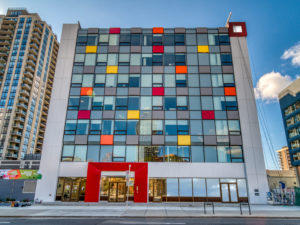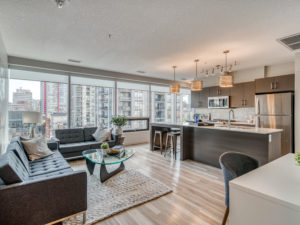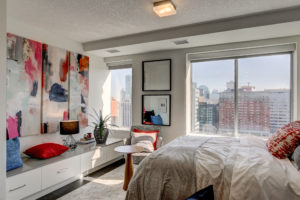A new pilot project provides developers with the tools to help make existing high density buildings more sustainable
By Jim Timlick

A new pilot project provides developers with the tools to help make existing high density buildings more sustainable
By Jim Timlick
Manitoba builders can now access a new tool that has been designed to help make it easier for them to develop more sustainable housing.
In September, Built Green Canada officially launched its High Density Renovation Program (HDRP). The pilot project provides builders with the means to renovate existing high density residential and mixed-use buildings in a more sustainable manner. The ultimate goal of the program is to provide both owners and occupants with healthier, more durable and more affordable living spaces by reducing operating and maintenance costs. It’s a complement to one of Built Green’s other existing sustainable building programs, the Single Family Renovation Program.
Built Green CEO Jenifer Christenson says the high density program was developed in response to demands by a growing number of Canadians for more sustainable options when it comes to older housing stock. The 2018 the Canadian Home Builders’ Association (CHBA) Home Buyer Preference Study indicated that 67 per cent of Canadian homebuyers say a high-performance home is a “must have” and 44 per cent said low-flow toilets are also a “must have.”
How best to proceed
“Climate mitigation is permeating our reality, whether that’s through social, trade and mainstream media, alongside all orders of government putting this high on their agenda. There’s a lot of people out there – industry, government and citizens – who want to progress this social problem and there’s a lot of questions about how best to proceed,” Christenson said.
To qualify for the program, applicants must demonstrate that substantial upgrades or retrofits will be made to the building envelope and its mechanical- and energy-related systems. Other areas of sustainability must also be considered including materials and methods, waste management, water conservation and business practices. Built Green provides support on how to attain those objectives as well as a guide that offers suggestions on which green features can be used for a project. Applicants are then required to choose from a checklist that offers choices on which features they will integrate into the project. Energy performance, as well as points earned in the other areas of the checklist determine which level of certification the project will be awarded: bronze, silver, gold or platinum.
Builders can recoup a portion of their upgrade costs through incentives and rebates available from various provincial and municipal governments, electric and natural gas utilities and some financial institutions. In Manitoba that includes a number of Manitoba Hydro initiatives including the Affordable Energy Program, Building Envelope Program and Custom Measures Program.
A holistic approach
While energy efficiency is an important part of the program, Christenson stresses HDRP takes a holistic approach to sustainability. It focuses on seven key areas including:
Christenson says that water management is a critical piece of the program since “water conservation in the residential building industry has not received the attention energy efficiency has, though they are both connected and significant.”
One of the options available to builders and renovators for water conservation through HDRP is the Water Efficiency Rating System (WERS). It’s the first performance-based water rating system in Canada and was developed by the Green Builder Coalition in late 2018. It considers all indoor water-use fixtures such as toilets, showers, clothes washers and structural waste, and provides a score ranging between zero and 100 with zero being the top score. WERS includes the ability to account for all outdoor water use, as well as reuse via rainwater, greywater and blackwater catchment calculations.
Calgary-based Strategic Group was the first company to sign up for the HDRP. It owns, manages, leases and develops residential and commercial properties across the country. Christenson says the company’s appreciation for environmental sustainability – it already has several of its own energy reduction and conservation programs in place – made it a perfect fit for what Built Green is hoping to achieve with HDRP.
To date, Strategic Group has enrolled four high density projects in HDRP. One of those projects, a mixed-use building with 65 one- and two-bedroom suites in Calgary’s inner-city, has already been completed.
Projects on tap
Perhaps the most notable of the four projects is a makeover of the iconic Barron Building in downtown Calgary. When it opened in 1951, it was the city’s first high-rise at 12 storeys and a symbol of Calgary’s economic, social and political growth. As part of the rehabilitation of the 85,223 square foot office building, it is being repurposed into a mixed-use space with retail shops and 94 rental residences. Strategic Group plans to preserve the art deco-style façade of the building while building modern residences inside.
Further west in B.C., another ownership group that hasn’t publicly identified itself, is in the process of applying to Built Green to be accepted in to HDRP as part of a project to develop a historic building into a multi-family residential structure.
Christenson says the program offers a potential win-win for developers and tenants. Increased home efficiency means long-term costs savings on water, electricity and gas bills for residents while increased durability means reduced future renovation costs for developers as long as they remain the owner of the building.
Although Built Green officials are optimistic about the level of interest in the program, they acknowledge that it could take some time for more builders and developers to get on board.
“Right now, we’ll grow the program slowly with participation during this pilot phase, which will garner further industry input, consider various specification scenarios and allow for appropriate updates so we may continue to improve this program,” Christenson said. “This process will contribute to our programs getting better and better, and alongside growing expectations for more sustainable building practices, we will grow awareness and support.”
Local interest
So far, no Manitoba companies have applied to take part in the HDRP, but Christenson expects that to change as people become aware of it.
“We are active in various provinces across the country and if a builder, renovator or developer wants to work with us we would welcome the opportunity to work with them,” she said, adding that HDRP could be an important tool for developers looking to preserve or repurpose some of the aging, but still valuable, buildings located in Winnipeg and surrounding communities.
Built Green Canada is an industry-driven, non-profit organization that was started in Calgary in 2003 to offer sustainable building programs for the residential building industry. Its membership includes more than 385 builders and renovators across the country including two in Manitoba: Sunstone Resort Communities in Winnipeg, and Westman Premier Homes in Brandon. Membership fees are $250 and $500 annually, based on the size of the business. Certification for its various programs is offered at a minimal cost: $120 for a single-family home and $100 per unit up to a maximum of $20,000 for high density projects.
For more information about Built Green Canada and the High Density Renovation Program visit www.builtgreencanada.ca.



Romolo Tavani/123rf